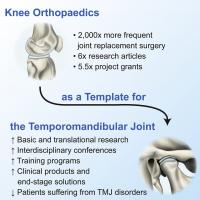
One Health Collaboration Spotlights Disparities in Knee and Jaw Joint Treatments
There are many similarities between the usage, and consequent injury, in knee joints and the jaw’s temporomandibular joint (TMJ). However, knee orthopedics are better researched and funded, resulting in tissue-engineered products and other ways to improve the lives of those affected.

Dr. Boaz Arzi, professor and dentist/maxillofacial surgeon with the UC Davis School of Veterinary Medicine, joined biomedical engineers and orthopedic surgeons from UC Irvine, orthopedic surgeons from Harvard University, oral/maxillofacial surgeons from the University of Texas, and oral/maxillofacial radiologists to research the subject further.
Their collaboration resulted in a review paper recently published in Cell Reports Medicine. It looks into the reasonings behind the disparities and takes a deep dive into both joints to explore how TMJ funding can be improved to further advance the field.
To improve future research and treatment, the team looked at all aspects of research – how research is accessed, how research is performed, and how research is funded.

The cross section of veterinarians, physicians, dental surgeons, biomedical engineers, and radiologists resulted in a One Health perspective ultimately focused on improving the health of humans and animals.
The review paper is a result of National Institutes of Health grants received to conduct the research.
